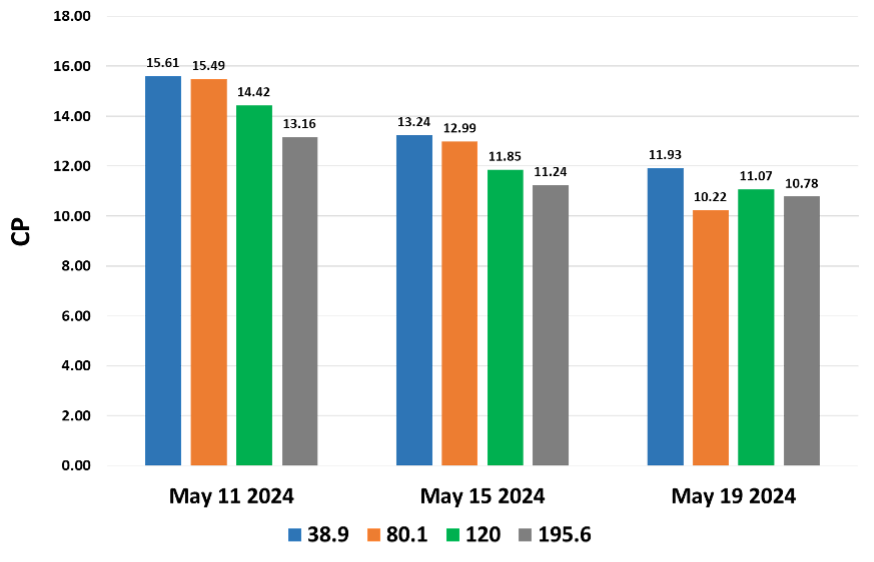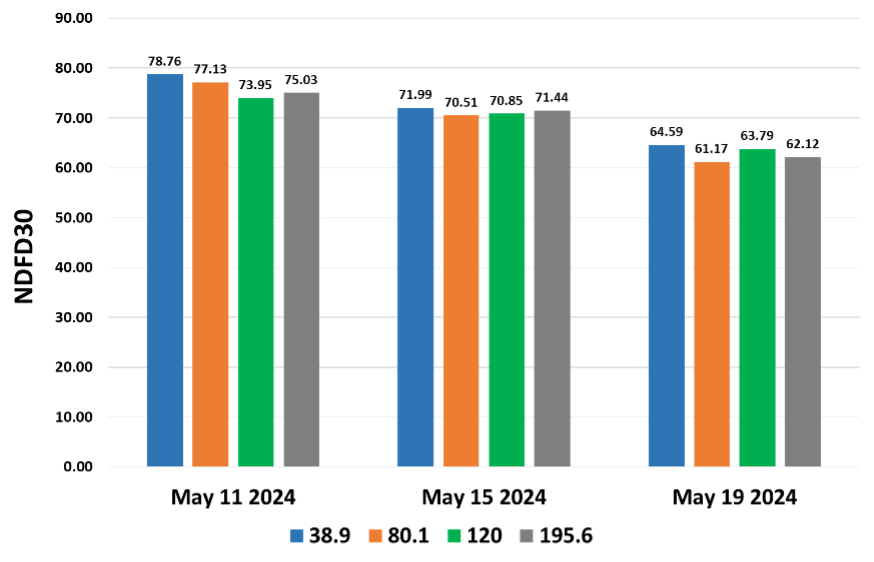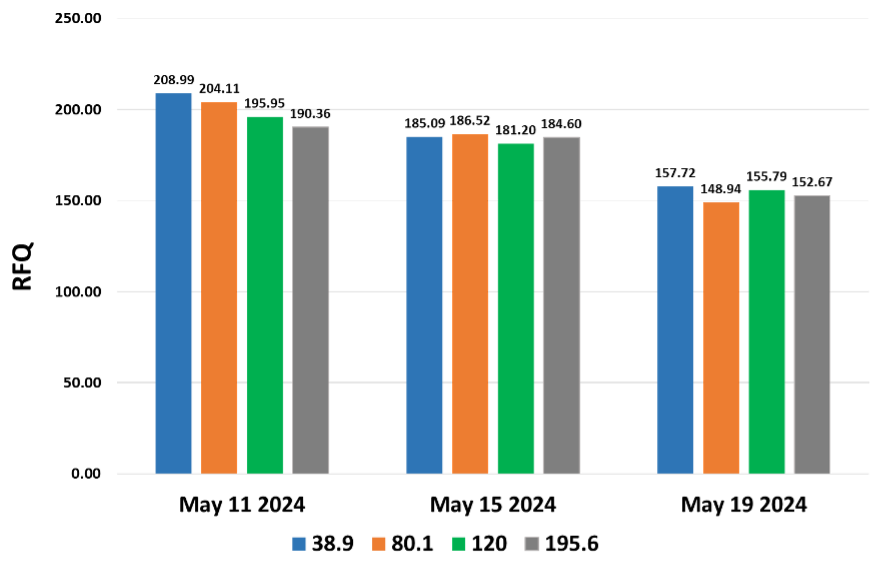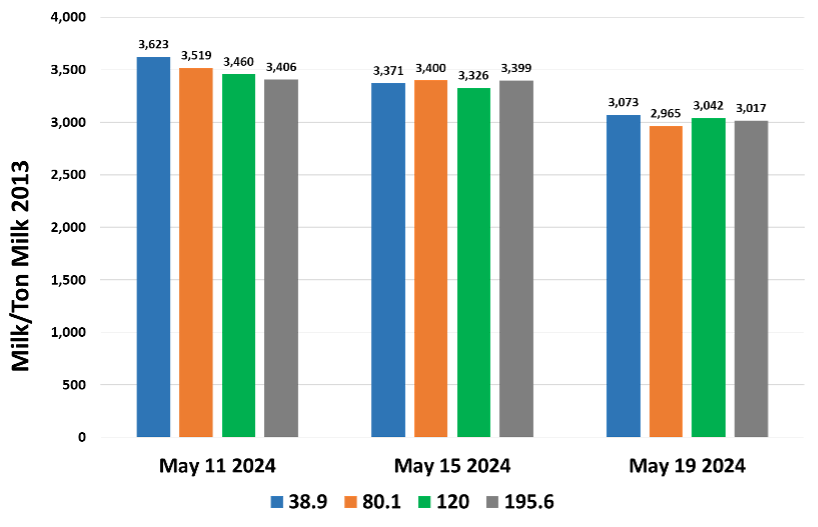The soil health benefits winter cereal forages offer combined with the opportunity to harvest high quality forage has made them a mainstay on many farms across Wisconsin. When managed and harvested correctly, these forages can be utilized in the lactating dairy ration due to their high neutral detergent fiber digestibility (NDFD).
As acreage continues to grow, so does the need to monitor the maturing crop vigilantly this time of year. Cereal rye offers you the opportunity to harvest lactating dairy quality forage, however, one can easily miss the window of opportunity for harvest given the numerous other tasks that compete for priority on any given the farm this time of year.
Introduction to Outagamie County Cereal Rye Forage Research
Cereal rye research plots were established in Outagamie County in the fall of 2023 and harvested in the spring of 2024 to evaluate the impact of seeding rate on forage yield and quality. Each treatment was replicated three times and plots were fertilized based off current soil test results using UW recommendations.
Cereal rye was planted at rates of 38.9 lb./a, 80.1 lb./a, 120 lb./a, and 195.6 lb./a. The seeding rates are represented in blue, orange, green, and gray in the charts below. Three harvest dates were selected May 11 – Flag Leaf, May 15 – Boot Stage, May 19 – Heading to evaluate the impact of delaying harvest by four days may have one overall quality and quantity of the forage harvested.
Nutritionists generally identify four or five metrics they evaluate when trying to get an impression of a forage’s value based on a quality analysis report. Dry matter (DM), crude protein (CP), neutral detergent fiber digestibility (NDFD), relative forage quality (RFQ), and milk per ton (MPT) are among the most common indicators.
Percentage (%) Crude Protein (CP): Cereal Rye Seeding Rate Project
Let’s begin with crude protein. The impact of delaying cutting on crude protein (CP) levels can be seen amongst the differing seeding rates below.
While the lower seeding rates exhibited a generally higher level of CP, the trend is very clear. Crude protein averaged 14.67% on 5/11, 12.33% on 5/15 and 11.0% on 5/19.

Depending on the intended use of your forage, losing a couple of points of CP (2.34% from 5/11-5/15 and 1.33% from 5/15-5/19) may be considered a fair trade off given the potential significant increase in dry matter (DM) yield that may be observed by delaying cutting from flag leaf to boot stage.
Neutral Detergent Fiber Digestibility (NDFD) 30-Hour Cereal Rye Seeding Rate Project
Neutral Detergent Fiber Digestibility (NDFD) 30-Hour levels averaged 76.22% on 5/11, 71.20% on 5/15, and 62.92% on 5/19. NDFD reductions of 5.02% and 8.28 % were observed from 5/11-5/15 and 5/15-5/19 respectively.

Relative Forage Quality (RFQ) Cereal Rye Seeding Rate Project
Relative Forage Quality (RFQ) levels averaged 199.85 on 5/11, 184.35 on 5/15, and 153.78 on 5/19. RFQ reductions of 15.50 and 30.57 were observed from 5/11-5/15 and 5/15-5/19 respectively. RFQ rates declined by nearly twice as much when first moving from flag to boot (15.5) and then boot to heading (30.57). Once we observe plants entering the reproductive stage, quality has already taken a substantial hit.

Milk Per Ton (MPT) Cereal Rye Seeding Rate Project
The last quality characteristic we want to discuss is milk per ton (MPT). MPT levels averaged 3,502 lbs./ton on 5/11, 3,374 lbs./ton on 5/15, and 3,024 lbs./ton on 5/19. MPT reductions of 128 lbs./ton. and 350 lbs./ton were observed from 5/11-5/15 and 5/15-5/19 respectively. MPT rates declined nearly threefold when first moving from flag to boot (128 lbs./ton) and then boot to heading (350 lbs./ton).

Rain is Expected: Should I cut, or should I wait?
Harvesting winter cereals in May often results in the risk of quality degradation due to precipitation events resulting in field losses. Below is an example of a one-day difference between cereal rye that was cut on 5/10 and received a one-time one-inch rainfall versus cereal in the same field that was measured the day after without damage at the cereal rye seeding rate plot site in Outagamie County. Each farm needs to consider the total number of field days available for fieldwork and how delays in harvesting winter cereals may impact planting dates and final yields of crops following those winter cereals.
| Measure of Forage Quality | Cut on 5/10/24 1″ Rain Damaged | Cut on 5/11/24 No Rain Damage |
|---|---|---|
| Crude Protein (CP) | 17.60 | 13.01 – 16.62 |
| Total Digestible Nutrients (TDN) | 66.14 | 67.11 – 72.82 |
| Neutral Detergent Fiber Digestibility (NDFD 30) | 72.08 | 69.47 – 81.17 |
| Relative Forage Quality (RFQ) | 177.97 | 186.95 – 216.29 |
| Milk Per Ton (MPT) | 3,245 | 3,345 – 3,704 |




